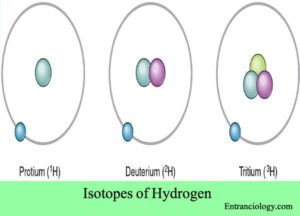Hydrogen (Symbol ‘H’) is a chemical element which was recognized as a separate substance by Cavendish in the year 1776. Hydrogen was named by Lavoisier, and is the most abundant of all elements in the universe.
Facts About Hydrogen
- Atomic Number : 1
- Atomic Symbol : H
- Atomic Weight :008
- Electron Configuration : 1s1
- Latin Name : Hydrogenium (Gr. Hydro : Water, and Genes : Forming )
- Atomic Radius : 78 pm
- Melting Point : -259.34 oC
- Boiling Point : -252.87 oC
- Oxidation States : 1, -1
Sources of Hydrogen
Hydrogen is generally prepared by
- Electrolysis of the water
- Boiling water on Zinc, Magnesium, Aluminium or their Amalgams
- Cold water on Sodium, Calcium or Potassium
- Steam on heated Magnesium, Iron or Zinc
- Reaction of Sodium or Potassium Hydroxide on Aluminium, Tin, Zinc, Silicon etc.
- by displacement from acids by certain metals
- by decomposition of certain Hydrocarbons with heat
Compounds of Hydrogen
Although pure Hydrogen is a gas, it is found in very small amount in the atmosphere. On the Earth, Hydrogen (H) occurs chiefly in combination with Oxygen in the water, but it is also present in organic matter like petroleum, living plants, coal etc. Hydrogen (H) combines with other elements sometimes explosively to form compounds.
Forms of Hydrogen
Hydrogen gas is mixture of 2 kinds of molecules, called Ortho and Para Hydrogen, which differ from one another by the spins of their electrons and nuclei. Normal Hydrogen (H) at room temperature (25 oC) contains 75 percent of the Ortho form and 25 percent of the Para form. The ortho form can’t be prepared in the pure state. The energy level and physical properties of both are different. The melting and boiling points of parahydrogen are about 0.1 oC (zero point one degree Celsius) lower than those of normal Hydrogen.
Isotopes of Hydrogen
The ordinary isotopes of the Hydrogen, H, called Protium, the other two isotopes are Deuterium (a Proton and a Neutron) and Tritium (a Proton and two Neutrons). Hydrogen is the only known element whose isotopes are having different names. The Deuterium and The Tritium are both used as fuel in the nuclear fusion reactors. Deuterium is utilized as a moderator to slow down neutrons. Tritium atoms are also present, but in much smaller proportions. Tritium is readily prepared in nuclear reactors, and is used in the production of the Hydrogen (fusion) bombs. It is also utilized as a radioactive agent in manufacturing of luminous paints and as a tracer.

Uses of Hydrogen
Hydrogen (H) is required commercially for Haber’s process (industrial preparation of the Ammonia), and for the Hydrogenation of oils and fats. Other uses of the Hydrogen include welding, rocket fuel, Methanol, reducing metallic ores, producing Hydrochloric Acid (HCL), and filling the balloons.


